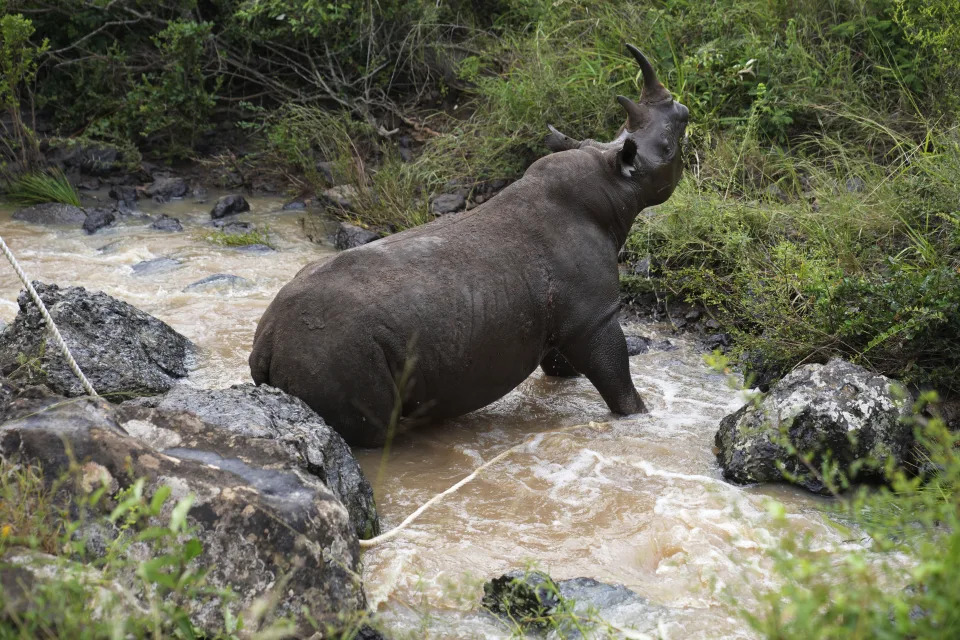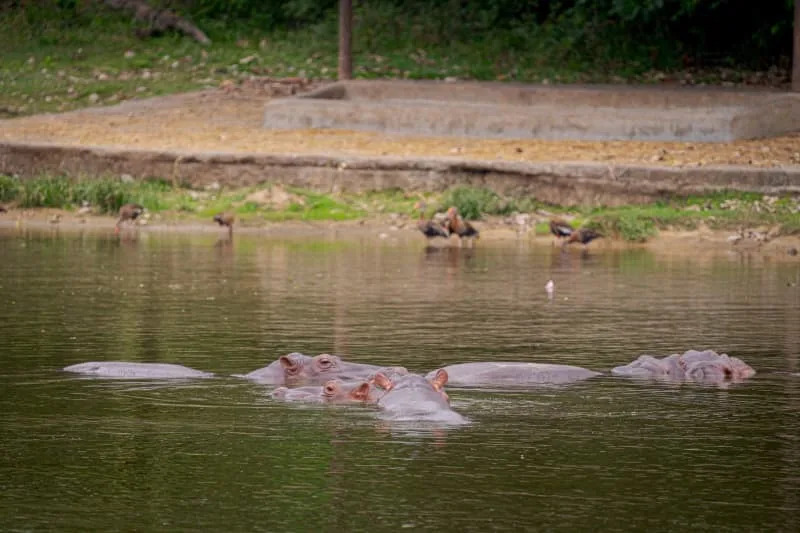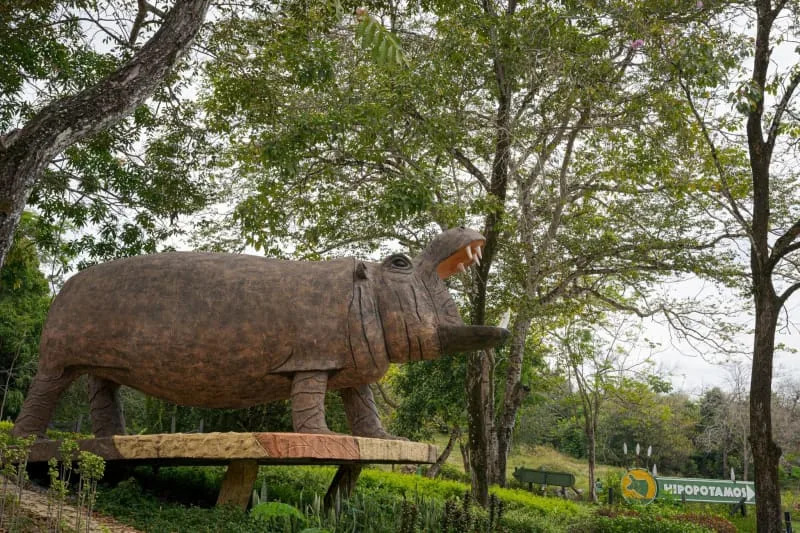BRIAN INGANGA and GERALD IMRAY
Tue, January 16, 2024








Kenya Relocating Rhinos
Kenya Wildlife Service vet prepares injectinion drugs to dart 21 endangered black rhinos in Nairobi National Park, Kenya Tuesday, Jan. 16, 2024. Kenya has embarked on its biggest rhino relocation project ever and began the difficult work Tuesday of tracking, darting and moving 21 of the critically endangered beasts, which can each weigh over a ton, hundreds of miles in trucks to a new home. A previous attempt at moving rhinos in the East African nation in 2018 was a disaster as all 11 of the animals that were relocated died.
(AP Photo/Brian Inganga)
NAIROBI, Kenya (AP) — Kenya has embarked on its biggest rhino relocation project and began the difficult work Tuesday of tracking, darting and moving 21 of the critically endangered beasts, which can each weigh over a ton, to a new home.
A previous attempt at moving rhinos in the East African nation was a disaster in 2018 as all 11 of the animals died.
The latest project experienced early troubles. A rhino targeted for moving was not subdued by a tranquilizer dart shot from a helicopter. Wildlife rangers on the ground attempted to restrain the rhino with a rope but decided to release the animal to make sure it was not harmed.
Wildlife officials have stressed that the project will take time, likely weeks.
The black rhinos are a mix of males and females and are being moved from three conservation parks to the private Loisaba Conservancy in central Kenya, the Kenya Wildlife Service said. They are being moved because there are too many in the three parks and they need more space to roam and, hopefully, to breed.
Rhinos are generally solitary animals and are at their happiest in large territories.
Kenya has had relative success in reviving its black rhino population, which dipped below 300 in the mid-1980s because of poaching, raising fears that the animals might be wiped out in a country famous for its wildlife.
Kenya now has nearly 1,000 black rhinos, according to the wildlife service. That’s the third biggest black rhino population in the world behind South Africa and Namibia.
There are just 6,487 wild rhinos left in the world, according to rhino conservation charity Save The Rhino, all of them in Africa.
Kenyan authorities say they have relocated more than 150 rhinos in the last decade.
Six years ago, Kenya relocated 11 rhinos from the capital, Nairobi, to another sanctuary in the south of the country. All died soon after arriving at the sanctuary. Ten of them died from stress, dehydration and starvation intensified by salt poisoning as they struggled to adjust to saltier water in their new home, investigations found. The other rhino was attacked by a lion.
Some of the 21 rhinos in the latest relocation are being transferred from Nairobi National Park and will make a 300-kilometer (186-mile) trip in the back of a truck to Loisaba. Others will come from parks closer to Loisaba.
The moving of the rhinos to Loisaba is poignant given the region was once home to a healthy black rhino population before they were wiped out in that area 50 years ago, said Loisaba Conservancy CEO Tom Silvester.
Kenyan wildlife authorities say the country is aiming to grow its black rhino population to about 2,000, which they believe would be the ideal number considering the space available for them in national and private parks.
___
Imray reported from Cape Town, South Africa.
___
AP Africa news: https://apnews.com/hub/africa
After much delay, Colombia is finally tackling its hippo problem
NAIROBI, Kenya (AP) — Kenya has embarked on its biggest rhino relocation project and began the difficult work Tuesday of tracking, darting and moving 21 of the critically endangered beasts, which can each weigh over a ton, to a new home.
A previous attempt at moving rhinos in the East African nation was a disaster in 2018 as all 11 of the animals died.
The latest project experienced early troubles. A rhino targeted for moving was not subdued by a tranquilizer dart shot from a helicopter. Wildlife rangers on the ground attempted to restrain the rhino with a rope but decided to release the animal to make sure it was not harmed.
Wildlife officials have stressed that the project will take time, likely weeks.
The black rhinos are a mix of males and females and are being moved from three conservation parks to the private Loisaba Conservancy in central Kenya, the Kenya Wildlife Service said. They are being moved because there are too many in the three parks and they need more space to roam and, hopefully, to breed.
Rhinos are generally solitary animals and are at their happiest in large territories.
Kenya has had relative success in reviving its black rhino population, which dipped below 300 in the mid-1980s because of poaching, raising fears that the animals might be wiped out in a country famous for its wildlife.
Kenya now has nearly 1,000 black rhinos, according to the wildlife service. That’s the third biggest black rhino population in the world behind South Africa and Namibia.
There are just 6,487 wild rhinos left in the world, according to rhino conservation charity Save The Rhino, all of them in Africa.
Kenyan authorities say they have relocated more than 150 rhinos in the last decade.
Six years ago, Kenya relocated 11 rhinos from the capital, Nairobi, to another sanctuary in the south of the country. All died soon after arriving at the sanctuary. Ten of them died from stress, dehydration and starvation intensified by salt poisoning as they struggled to adjust to saltier water in their new home, investigations found. The other rhino was attacked by a lion.
Some of the 21 rhinos in the latest relocation are being transferred from Nairobi National Park and will make a 300-kilometer (186-mile) trip in the back of a truck to Loisaba. Others will come from parks closer to Loisaba.
The moving of the rhinos to Loisaba is poignant given the region was once home to a healthy black rhino population before they were wiped out in that area 50 years ago, said Loisaba Conservancy CEO Tom Silvester.
Kenyan wildlife authorities say the country is aiming to grow its black rhino population to about 2,000, which they believe would be the ideal number considering the space available for them in national and private parks.
___
Imray reported from Cape Town, South Africa.
___
AP Africa news: https://apnews.com/hub/africa
After much delay, Colombia is finally tackling its hippo problem
DPA
Mon, January 15, 2024

Drug lord Pablo Escobar brought four hippos to Colombia during the 1980s, to live alongside other exotic animals in his private zoo on a luxury estate outside Medellín. After his death, the hippos escaped and have since proliferated vigorously, endangering the local ecosystem. The government has now come up with a new plan to tackle the invasive species. Luis Bernardo Cano/dpa
Drug baron Pablo Escobar once brought four African hippos to Colombia for his own private zoo and now they are a multi-tonne problem.
Escobar, the head of the powerful Medellín cartel, was shot dead in 1993, but his hippos remain and have since become an outsize pest, disrupting the local ecosystem, destroying fields and endangering residents.
The government long delayed tackling the invasive species but has now come up with a range of solutions, starting with sterilization.
"Surgical sterilization is just one of the three measures envisaged by the Ministry of the Environment as part of the plan to manage and check hippos in Colombia," says Colombian Environment Minister Susana Muhamad, who presented the plan.
Further steps are to include the euthanization and relocation of the animals.
Drug lord, narcoterrorist and politician Escobar brought the hippos to Colombia during the 1980s, to live alongside elephants, giraffes, kangaroos and other exotic animals in his private zoo on the luxury estate Hacienda Napolés, outside Medellín.
When Escobar was killed by security forces in 1993, the hippos were left to fend for themselves and the past 30 years saw the original four reproducing vigorously and spreading nationwide.
More than 160 specimens are said to currently live around the Rio Magdalena river where they are finding plenty of food and water and the climate is favourable.
With no natural enemies and without intervention, the population could grow to 1,000 animals by 2035, the minister says. She warned that such a development could threaten the original diversity of species.
Hippos, after all, can pollute the soil and water, unbalance the ecosystem and endanger local residents.
So far, though, many people have become accustomed to the animals and even use them for tourism.
But the risk of an attack remains. "You have to be very careful," says biologist David Echeverri from the Cornare regional environmental centre. Even if they appear to be a calm species, hippos are actually unpredictable.
Their weight means they are able to capsize boats.
One way to slow their spread is sterilization, albeit a "complex and costly process" according to the Ministry of the Environment. "There is a risk that the animals will die, that they will have an allergic reaction to the anaesthetic or that the human team on site will be endangered," the minister says.
Sterilizing a hippopotamus costs an average of 40 million pesos (around $10,302).
The government wanted to sterilize 20 animals by the end of 2023 and 40 per year after that.
But further measures are needed beyond sterilization, leading the government to look to relocations. Talks are currently being held with Mexico, India and the Philippines. India has already offered to take in 60 animals.
There are also plans to assess how the animals can be euthanised under moral aspects and the ministry is working on an ethical euthanasia protocol for this purpose. No details have yet been released.
Leaders in the past have also attempted to address the burgeoning population. "There is not one measure that would be effective enough to guarantee that they stop reproducing," says Echeverri.
Simply shooting the hippos, which researchers have already recommended, is out of the question for the state of Antioquia and other animal-loving Colombians.
There was massive outrage nationwide when Pepe, a stray hippopotamus, was shot on ministry orders in 2009 and soldiers posed with the slain animal.
Meanwhile, sending the hippos to Africa could do more harm than good, specialists fear.
"When we transport animals or plants from one place to another, we also transport their pathogens, bacteria and viruses," says biology professor María Ángela Echeverry from the Javeriana University in Bogotá. "We could bring new diseases to Africa."
These complexities are partly why the country has been waiting a long time for a plan to tackle this problem.
"None of the three measures is effective on its own, but it is important that they are implemented simultaneously," says the minister. "We are in a race against time here."

A hippo roaming around the Hacienda Naplés, the former luxury estate of Colombian drug lord Pablo Escobar. Sinikka Tarvainen/dpa

Fishermen on Colombia's Rio Magdalena river. Drug lord Pablo Escobar brought four hippos to Colombia during the 1980s, to live alongside elephants, giraffes, kangaroos and other exotic animals in his private zoo on the luxury estate Hacienda Napolés, outside Medellín. After his death, the hippos escaped and have since proliferated vigorously, with many said to live around the river. Luis Bernardo Cano/dpa

A hippo statue inside the Hacienda Nápoles, the former estate of Colombian drug lord Pablo Escobar and home to his private zoo, now a popular spot for observing hippos. Luis Bernardo Cano/dpa
No comments:
Post a Comment